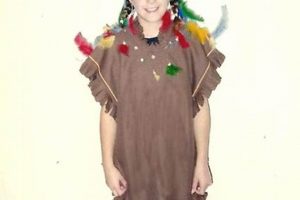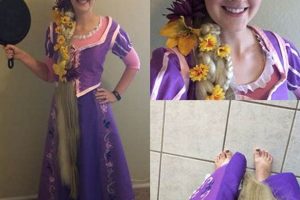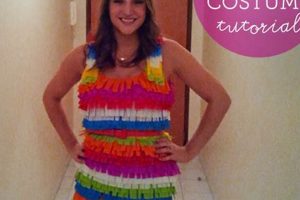Creating personalized attire for dolls, specifically those modeled after the iconic Barbie figure, involves a range of crafting techniques. These projects often entail repurposing existing materials, sewing new garments from scratch, or embellishing pre-made doll clothes to achieve a desired aesthetic. As an example, one might transform a child’s old sock into a fitted dress for a doll, or design and sew a miniature ballgown using scraps of fabric.
Engaging in such crafting projects fosters creativity and resourcefulness. The practice allows individuals to express their artistic vision while simultaneously minimizing waste through material reuse. Historically, crafting doll clothes has served as an accessible entry point to sewing and design principles, providing practical skills and a sense of accomplishment.
The following sections will delve into various approaches for designing and constructing miniature doll apparel, covering essential tools, fundamental sewing techniques, and design inspiration for unique and personalized doll wardrobes.
Guidance on Creating Personalized Doll Apparel
The following recommendations provide practical assistance in the creation of individualized doll attire, encouraging skillful execution and innovative design.
Tip 1: Prioritize Measurement Accuracy: Precise measurements of the dolls body are crucial for ensuring proper garment fit. Record dimensions such as bust, waist, hip, and torso length before commencing pattern drafting or fabric cutting. A flexible measuring tape is recommended for accuracy.
Tip 2: Select Appropriate Fabrics: Choose lightweight and pliable fabrics, such as cotton, silk, or fine knits, for ease of manipulation and a realistic drape on a miniature scale. Avoid bulky or stiff materials that may hinder garment construction and aesthetic appeal.
Tip 3: Employ Simplified Pattern Designs: Begin with basic pattern shapes, such as rectangles and squares, to construct simple garments. Gradually introduce more complex pattern elements, such as darts and curves, as skills progress. Utilize online resources or commercially available doll clothing patterns as templates.
Tip 4: Master Essential Hand-Sewing Techniques: Develop proficiency in hand-sewing stitches such as the backstitch, running stitch, and slip stitch for precise and durable garment construction. These techniques are particularly useful for small details and intricate areas that may be difficult to access with a sewing machine.
Tip 5: Utilize Fabric Glue Sparingly: Employ fabric glue as a supplementary tool for securing hems, embellishments, and closures. Exercise caution to prevent excessive glue application, which can stiffen fabric and detract from the garment’s overall appearance.
Tip 6: Incorporate Recycled Materials: Repurpose scraps of fabric, ribbon, lace, and buttons from existing garments or craft supplies to create unique and sustainable doll clothing. This approach minimizes waste and encourages creative problem-solving.
Tip 7: Emphasize Detail and Embellishment: Enhance the visual appeal of doll attire through the addition of carefully selected embellishments, such as beads, sequins, embroidery, or miniature trims. Consider the scale and proportion of embellishments to maintain a balanced aesthetic.
Adherence to these guidelines facilitates the production of well-crafted and visually appealing doll apparel. Skillful application of these techniques yields personalized items exhibiting a refined aesthetic.
The subsequent sections will address advanced design concepts and creative embellishment strategies for further customization of doll wardrobes.
1. Fabric Selection
Fabric selection is a foundational element in the successful creation of “diy barbie costumes”. The properties of the chosen material directly influence the drape, texture, and overall aesthetic of the finished garment. For instance, selecting a lightweight cotton fabric will yield a vastly different result than opting for a heavier, stiffer material such as denim or canvas. Improper fabric selection can lead to ill-fitting, unflattering, or structurally unsound miniature garments. The cause-and-effect relationship is evident: the type of fabric selected dictates the characteristics of the final product.
The practical significance of understanding fabric properties lies in the ability to tailor the garment to a specific design vision. For example, a flowing ballgown might necessitate the use of silk or chiffon, while a more structured outfit, like a tailored jacket, could require a firmer fabric such as twill. Moreover, the scale of the fabric pattern is also crucial; large prints can overwhelm a miniature garment, whereas smaller, more delicate patterns are generally more suitable. Attention to fabric content, weave, and weight ensures the creation of proportionate and aesthetically pleasing doll attire.
In summary, appropriate fabric selection is not merely a superficial choice but a fundamental design consideration within the realm of “diy barbie costumes”. Recognizing the impact of fabric properties on the final product enables creators to execute their designs effectively, resulting in miniature garments that are both visually appealing and structurally sound. Challenges may arise in sourcing appropriately scaled fabrics, however, careful consideration of existing materials and resourcefulness in repurposing fabrics can mitigate these obstacles.
2. Pattern Creation
The generation of patterns represents a pivotal stage in the realization of miniature doll apparel. Accurate patterns serve as blueprints, guiding the precise cutting and assembly of fabric pieces to form a cohesive garment. The absence of a well-defined pattern introduces uncertainty and increases the likelihood of structural flaws within the finished product.
- Drafting Techniques
Drafting involves the direct creation of a pattern from measurements taken from the doll’s body. This method necessitates a comprehensive understanding of pattern-making principles, including dart manipulation and seam allowance considerations. For example, a simple A-line dress pattern begins with a rectangular block, subsequently modified through dart placement to achieve the desired silhouette. Improper drafting leads to fit issues.
- Adapting Existing Patterns
Existing patterns, whether sourced from commercial pattern companies or online resources, can be adapted to suit the specific dimensions of a particular doll. This process often involves scaling patterns proportionally or adjusting individual pattern pieces to accommodate unique body shapes. For instance, one might reduce a standard child’s dress pattern to approximately 1/6th its original size for a typical fashion doll. Over-reduction can distort intended design.
- Muslin Mock-ups
Prior to cutting into the final fabric, the creation of a muslin mock-up allows for the evaluation of pattern fit and design aesthetics. This iterative process involves constructing a preliminary garment from inexpensive fabric, such as muslin, and making necessary alterations before proceeding to the final fabric. A poorly fitted muslin translates to problems in later stages.
- Digital Patterning
Computer-aided design (CAD) software offers an alternative approach to pattern creation, enabling the precise drafting and modification of patterns in a digital environment. This method facilitates the creation of intricate designs and the easy replication of patterns in various sizes. A digital pattern allows for changes that are difficult to make on paper.
The successful application of these pattern creation methods is essential for achieving professional-looking and well-fitting “diy barbie costumes”. Selecting the appropriate method depends on the designer’s skill level, available resources, and the complexity of the intended garment design. Experimentation with different approaches encourages both technical proficiency and creative expression in miniature garment design.
3. Sewing Technique
Proficiency in varied sewing techniques is fundamental to the production of high-quality miniature doll apparel. The chosen method directly influences the durability, appearance, and overall structural integrity of “diy barbie costumes”. Mastery ensures precision and aesthetic appeal in the final product.
- Hand Stitching
Hand stitching provides control and precision essential for intricate details. Techniques such as the backstitch offer strength and security along seams, while the slip stitch creates invisible hems. The application is observed in the creation of delicate embellishments or securing fine trims where machine stitching is impractical. Its absence leads to structural weakness.
- Machine Sewing
Machine sewing expedites garment construction, producing uniform and durable seams. Techniques such as straight stitching, zigzag stitching, and serging are utilized. It offers speed and consistency in constructing the main body of doll clothes. Inadequate skill results in uneven seams and potential fabric damage.
- Seam Finishes
Seam finishes protect raw edges from fraying, enhancing the longevity and appearance of the garment’s interior. Techniques such as zigzag stitching, serging, or bias tape binding are employed. They increase garment durability. Neglecting seam finishing results in unraveling and a lower-quality appearance.
- Dart Manipulation
Dart manipulation creates shape and dimension in garments, allowing fabric to conform to the doll’s contours. Darts are strategically placed and sewn to achieve a fitted silhouette. They give the garment a 3D quality. Incorrect dart placement results in ill-fitting and unflattering garments.
The correlation between proficient sewing techniques and the resulting quality of “diy barbie costumes” is direct. Precision and structural integrity necessitate mastery of hand stitching, machine sewing, seam finishes, and dart manipulation. Investment in skill development amplifies the aesthetic and practical value of the handmade miniature wardrobe.
4. Scale Accuracy
Scale accuracy serves as a non-negotiable principle in the successful creation of “diy barbie costumes”. Deviations from correct proportions compromise the realism and aesthetic value of miniature garments. Precision ensures authenticity in the design and representation of the outfit.
- Pattern Proportionality
Pattern pieces must maintain accurate ratios relative to the doll’s dimensions. If the bodice length is improperly scaled, the garment will either be too short or too long, distorting the intended silhouette. For example, a pattern scaled at 1:6 for a standard fashion doll must accurately reflect the doll’s measurements; any deviation renders the garment unwearable. Correct proportionality ensures proper fit.
- Detailing Appropriateness
The scale of trims, buttons, and embellishments must correspond to the overall garment size. Oversized buttons on a miniature jacket appear disproportionate and detract from the realism of the design. Selecting appropriately sized details preserves the intended aesthetic. For instance, miniature zippers and snaps designed specifically for doll clothing are essential. Inappropriate detailing diminishes authenticity.
- Fabric Weight Considerations
The weight and texture of fabric must align with the scale of the garment. A heavy brocade fabric, while suitable for a full-sized gown, overwhelms a doll-sized garment, creating an unnatural drape. Lighter-weight fabrics such as silk or fine cotton maintain a more realistic appearance. Material selection must acknowledge the garment’s miniaturized scale. Overly heavy fabrics ruin the drape and fit.
- Seam Allowance Precision
Seam allowances, though small, directly impact the fit and appearance of miniature garments. Excessive seam allowances create bulk and distort the garment’s shape, while insufficient seam allowances compromise seam strength. Precise seam allowance measurements are critical for accurate construction. For example, a 1/8-inch seam allowance is often sufficient for doll clothing. Sloppy seam allowances lead to fit inaccuracies.
These dimensions underscore scale accuracy’s impact on “diy barbie costumes,” shaping aspects from fit to fabric weight. Consistent execution, ensures items possess a refined and authentic quality, mirroring details found in full-sized garments.
5. Embellishment Options
The strategic selection and application of embellishments significantly elevate the aesthetic value and realism of “diy barbie costumes.” These additions, ranging from miniature beads and sequins to intricate lacework and embroidery, impart character and refine the overall design. The absence of thoughtful embellishment choices often results in a visually underwhelming or incomplete representation of the intended costume. An example illustrates this point: a miniature ballgown constructed from satin fabric benefits immensely from the addition of strategically placed sequins, simulating the sparkle of a real-life formal dress. In contrast, a plain, unadorned gown, while structurally sound, lacks the visual impact and refinement achieved through the judicious use of embellishments. An increased focus on embellishments ensures quality and detailing.
Real-world applications of embellishment options involve the meticulous sourcing and application of appropriately scaled materials. For instance, selecting miniature buttons, rather than standard-sized ones, is critical for maintaining accurate proportions within the miniature garment. Similarly, the application of fine embroidery threads, rather than coarser yarns, allows for the creation of delicate and intricate designs that mirror the detail found in full-sized garments. The utilization of appropriate embellishment techniqu
es also ensures the longevity and durability of the embellishments themselves. For example, carefully hand-sewing beads onto a garment, rather than relying solely on adhesive, mitigates the risk of detachment and prolongs the garment’s lifespan. Such a demonstration requires careful and measured steps.
In summary, the thoughtful integration of embellishment options is paramount to the success of “diy barbie costumes.” The effective selection and application of embellishments enhances the visual appeal, realism, and overall quality of miniature garments. Challenges may arise in sourcing appropriately scaled embellishments, however, careful planning and creative resourcefulness can overcome these obstacles. The meticulous attention to detail, embodied by the judicious use of embellishments, elevates the artistry of “diy barbie costumes,” transforming them from mere doll clothes into miniature works of art. Careful embellishments must be carefully stored in a safe container.
6. Closure Mechanisms
The selection and implementation of appropriate closure mechanisms are inextricably linked to the functionality and aesthetic of miniature doll apparel. Without effective closures, “diy barbie costumes” would lack practicality, rendering them incomplete. A closure allows a garment to be donned and removed with relative ease, while also contributing to the overall fit and appearance. The omission of a suitable closure leads to difficulties in dressing and undressing the doll, potentially causing damage to the garment or the doll itself.
Practical examples demonstrate the importance of this element. A miniature dress may utilize small snaps, hooks and eyes, or Velcro closures along the back seam, ensuring a snug fit while enabling easy access. Similarly, a pair of doll-sized trousers could incorporate a miniature hook and bar closure at the waistband, mimicking the functionality of real-world clothing. The choice of closure is not arbitrary; it depends on the fabric, garment style, and desired level of realism. Improper choices compromise both functionality and aesthetics. For instance, bulky Velcro might be unsuitable for a delicate silk gown, while small snaps may lack the strength required for a durable denim jacket. Fabric weight and placement also greatly affect the performance of closures in the final product.
In summary, closure mechanisms represent a critical yet often understated aspect of “diy barbie costumes.” Their careful selection and application directly impact the usability and overall quality of the miniature garment. While sourcing appropriately scaled closures may present challenges, an understanding of their fundamental importance enables crafters to produce doll apparel that is both visually appealing and functionally sound. The inclusion of functional and aesthetically appropriate closures elevates the design and practicality of miniature doll wardrobes, adding an element of realism often neglected.
7. Durability Assurance
Durability assurance in the realm of “diy barbie costumes” is not merely a superficial concern but rather a critical factor influencing the long-term viability and enjoyment of these miniature creations. Ensuring that doll clothes withstand regular use and manipulation is essential for preserving their aesthetic appeal and extending their lifespan. Premature wear and tear detract from the value and satisfaction derived from these handmade items. Durability, when addressed successfully, contributes to a product’s lasting value.
- Seam Reinforcement
Reinforcing seams is a primary means of enhancing durability. Techniques such as backstitching at the beginning and end of seams, employing serged edges to prevent fraying, and utilizing appropriate seam allowances contribute significantly to garment strength. A miniature dress constructed with reinforced seams is less likely to fall apart under the stress of repeated dressing and undressing. Conversely, poorly reinforced seams are prone to unraveling, compromising the integrity of the garment. Garments made with seam reinforcement are more likely to stand the test of time.
- Fabric Selection for Resilience
Choosing durable fabrics is paramount to ensuring the longevity of “diy barbie costumes.” Fabrics such as tightly woven cotton, denim, or felt are more resistant to wear and tear than delicate materials such as silk or chiffon. While the latter may be aesthetically pleasing, their fragility makes them less suitable for doll clothes intended for regular use. The use of resilient materials translates to garments that withstand washing and repeated handling without significant damage. Weaving styles add tensile strength to textiles and apparel.
- Fastener Security
The method of securing fasteners, such as snaps, buttons, and Velcro, directly impacts the durability of “diy barbie costumes.” Fasteners that are loosely attached are prone to detaching, rendering the garment unwearable. Securing fasteners with reinforced stitching or utilizing high-quality adhesives ensures that they remain firmly in place, even with frequent use. A miniature coat with securely attached snaps will withstand repeated closures without risk of fastener loss. Strong attachments lead to increased value.
- Embellishment Attachment
The manner in which embellishments are attached to “diy barbie costumes” greatly affects their durability. Embellishments that are glued on are more likely to detach than those that are sewn on securely. Hand-sewing beads, sequins, and other decorative elements ensures that they remain firmly affixed to the garment, even after repeated washing and handling. Proper embellishment ensures consistent quality.
These facets of durability assurance illustrate the meticulous approach required in the creation of enduring “diy barbie costumes.” By prioritizing seam reinforcement, selecting resilient fabrics, ensuring fastener security, and employing robust embellishment attachment methods, creators can significantly extend the lifespan of their miniature garments. The additional effort invested in these measures translates to a more valuable and enjoyable end product, capable of withstanding the rigors of regular play and display.
Frequently Asked Questions
The following section addresses common inquiries and clarifies essential aspects related to the design and construction of miniature doll attire. These responses offer guidance for both novice and experienced crafters seeking to create high-quality “diy barbie costumes”.
Question 1: What fabrics are most suitable for crafting “diy barbie costumes”?
Lightweight and finely woven materials such as cotton, silk, and linen are generally preferred. These fabrics drape well on a small scale and are relatively easy to manipulate. Heavier fabrics, such as denim or velvet, may be used sparingly for specific designs, but their bulk can present challenges. Knit fabrics offer stretch and comfort, but require careful handling to prevent distortion.
Question 2: What tools are essential for creating miniature doll clothing?
Essential tools include a sharp pair of scissors, a flexible measuring tape, a fine-point needle, thread, pins, and a seam ripper. A small iron and ironing board are also highly recommended for pressing seams and achieving a professional finish. A sewing machine, while not
strictly necessary, can significantly expedite the construction process.
Question 3: How can patterns for “diy barbie costumes” be obtained?
Patterns can be drafted from existing doll clothes, adapted from commercial patterns designed for larger garments, or sourced from online resources specializing in doll clothing patterns. Drafting patterns requires a basic understanding of pattern-making principles. Adapting existing patterns necessitates scaling and adjusting pattern pieces to fit the specific doll’s measurements.
Question 4: What techniques can be used to ensure accurate seam allowances in miniature garments?
Accurate seam allowances are crucial for ensuring proper fit and preventing bulkiness in miniature doll clothes. A consistent seam allowance of 1/8 inch is generally recommended. A seam gauge can be used to maintain consistent measurements. Trimming excess fabric after stitching reduces bulk and facilitates clean, crisp seams.
Question 5: How can raw edges be effectively finished to prevent fraying in “diy barbie costumes”?
Raw edges can be finished using a variety of techniques, including zigzag stitching, serging, or applying bias tape binding. These methods prevent fraying and enhance the durability of the garment. A narrow hem, folded and pressed, also provides a clean and durable finish.
Question 6: What types of closures are most appropriate for miniature doll clothing?
Small snaps, hooks and eyes, and narrow Velcro strips are commonly used closures for “diy barbie costumes”. These closures are discreet and easy to manipulate. Buttons and buttonholes can also be used, but require careful execution due to their small size. The choice of closure depends on the garment style and desired level of functionality.
These responses provide a foundation for successful engagement with “diy barbie costumes” design and construction. Adherence to these guidelines will facilitate the creation of aesthetically pleasing and durable miniature garments.
The next section will discuss advanced techniques for creating more elaborate and customized doll wardrobes.
diy barbie costumes
This exposition has detailed fundamental aspects of crafting miniature doll attire, emphasizing critical areas such as fabric selection, pattern creation, sewing techniques, scale accuracy, embellishment options, closure mechanisms, and durability assurance. Proficiency in these elements directly influences the quality and aesthetic appeal of the final product.
Continued exploration and refinement of these skills allow for greater creative expression within the domain of miniature garment construction. A commitment to precision and detail will yield enduring results, elevating the craft from a simple pastime to an intricate art form. Additional study and continued practice in this form would lead to an mastery in craft.







